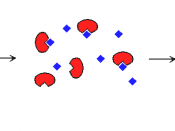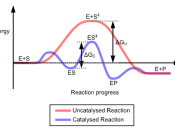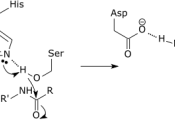*Note: THIS IS A STUDY GUIDE!! I did not write it to be considered as an essay, rather to assist any confused Bio students, help out with homework, or any other purpose that people see fit. Please do not critique my format, it's not an essay!
Enzymes are proteins that acts as catalysts in organisms. A catalyst is a substance that speeds up reactions without the addition of heat; decreases the activation energy needed for the reaction to take place by bringing molecules in contact with each other, no longer relying on chance collisions. Most enzymes end in 'ase'. The active site of the enzyme is the part that comes in contact with the substrate, which is the molecule acted on by the enzyme. There are 2 models that show how they work: -Lock and Key Model-active site only allows certain molecules to fit in, molecule separates and leaves, enzyme is unchanged and can be reused.
-Induced Fit Molecule- the active site is not rigid, changes as substrate enters.
Properties of Enzymes- A single enzyme molecule can catalyze thousands of substrate reactions per second, each enzyme only works on one type of reaction, enzymes are not changed or used up in a reaction, enzyme does not determine direction of reaction, lower temperature= rate of reaction will be reduced, higher=enzyme=more effective, too high=denaturization (enzyme begins to break down, changes shape to stop functioning. ) Optimum temperature= 25-40 C. Enzyme works best at a certain pH (7). Rate of reaction depends on concentration of enzyme and substrate, temperature, and pH. However, at high substrate concentrations, the rate will not increase further upon adding more substrate, which is known as saturability. Coenzymes- organic cofactors, some vitamins. Irreversible Inhibitors- bond to active site and permanently cripple the enzyme. Competitive Inhibitors- substances that...


